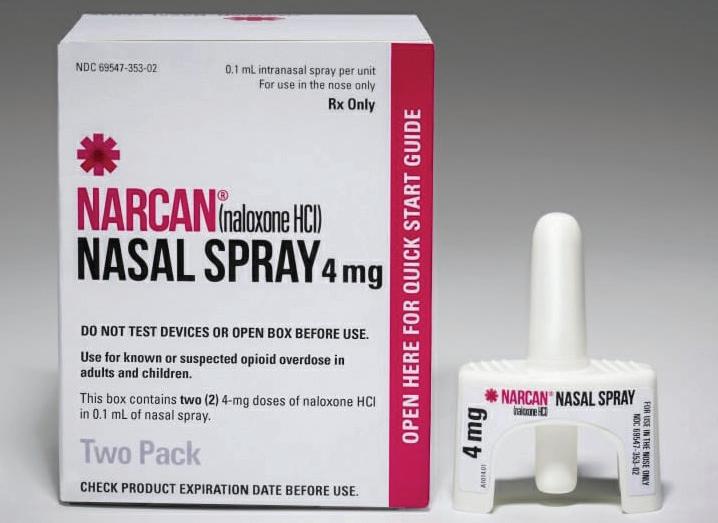
3 minute read
It’s the Weather Narcan-Opioids
By: Alex Guarini ‘26 Contributor
For many residents of the DMV, the snow-blanketed streets and driveways are a bright spot during the region’s cold winters, and generally, these desires are fulfilled; between the years 1991 and 2020, Washington, D.C. averaged nearly 14 inches of snow each winter. However, this year has been marked by unusual warmth and a lack of snow, with Dulles International Airport tallying a meager 0.4 inches of snow through February. Noting a common trend in recent years, many now wonder if this mild winter is the new norm.
Many might forget that the winter began immersed in below average temperatures. A historic cold system and numerous below-average days capped off December 1.6 degrees below average, making it the coldest in five years. People awaited even more frigid temperatures in January, but the cold never came. Instead, the month finished third warmest on D.C. record, and likewise, February finished as the second warmest on record with temperatures ranging from 16 degrees to 81 degrees.
Meteorologists now warn to bundle up for a cold March, with below average temperatures moving in dur- ing the middle to the end of the month. Fortunately for snow-lovers, however, Jon Gottschalk from the Climate Prediction Center is “cautiously optimistic” that the Mid-Atlantic will see snow during this period. This cold
By: Daniel Colucci ‘23 Editor
The presence of opioid addiction in the United States is no breaking story. Millions of Americans have died from overdose since the drugs first became prevalent in the United States in the early 2000s. The more recent rise of fentanyl and fentanyl laced substances only worsened a situation that was already out of hand. A drug that’s estimated to be 50 times stronger than heroin is practically a touch of death for many that come into contact with it.
overdose related incidents involving people 18 and younger.
zaga’s own preparation for such an occurrence.
spell should not affect D.C.’s famous cherry blossoms, which the National Park Service projects to achieve peak bloom as early as March 22.
Six of the top-ten warmest climatological winters — which includes the months of December, January, and February — have occurred since 2000. Experts blame climate change and urbanization for the increasingly warm winters in the DMV and say that these milder winters are here to stay. Nonetheless, there is good news for snow-lovers: Though climate change means D.C. will likely see fewer snow showers, it also will supposedly result in more immense winter storms and blizzards in the future.
This epidemic has now spread among the youth, and high school students in the DMV are no exception. Just last month a student at Wakefield High School in Arlington, Va. passed out dead in the school bathroom from an overdose. He was a freshman.
This is just one of many examples of overdoses that have occurred in our area recently. Montgomery County announced they have already had to administer narcan, a nasal spray used to treat narcotic overdoses 11 times since the beginning of the school year. Data collected over the last two years in the county shows a 78 percent increase in youth overdoses from 2021 to 2022, recording 48 overdoses with 11 of them resulting in death.

More broadly, northern Virginia as a whole has been struggling with the opioid crisis. State data says there were 289 hospital visits last year in Northern Virginia for
Ongoing incidents similar to the one described are finally prompting school counties to take initiative. Montgomery County Public Schools (MCPS) and Arlington Public Schools (APS) are among the various school districts leading the charge.
MCPS recently began holding “forums for families about fentanyl and naloxone training” along with promising that “Naloxone (Narcan) kits will be distributed to the families in attendance.”
In response to the Wakefield High School incident and the eight youth overdoses the county experienced last year, APS vows to place a “big emphasis on stocking Narcan in all APS schools, and training staff on how to use it.”
With such a high frequency of overdoses occurring in our area, one could consider Gonzaga fortunate to have not yet had its own incident. Mrs. Amy Harper, school nurse, detailed Gon-
“When I came here three years ago, I noticed you guys did not have narcan at Gonzaga, so I talked with Mr. [Jim] Kilroy and Mr. [Tom] Every about bringing it because I had it at my old school at St Alban’s,” Mrs. Harper said.
After successfully gaining permission to bring the life-saving drug on campus, Narcan is now stored in four places around the school.
“I have it in my office, the AED box in the Carmody Center and the AED box when you first walk into Kohlman. The athletic trainers have it, as well,” Mrs. Harper said.
As far as actually having to use narcan in the case of an overdose, all faculty recently received training on how to properly administer the drug. This training, paired with the relatively simple method of administering narcan, creates a basic foundation of preparation for Gonzaga to handle an overdose.
By: Jackson Baldrate ‘23 Editor-in-Chief
Last week, Silicon Valley Bank (SVB) made national news when it announced that it was closing its doors and being taken over by U.S. regulators. SVB is the second largest bank to collapse in United States history and the largest since the 2008 financial crisis. A variety of factors have been named as the reason for the failure. Some blame the Senate loosening regulations on medium size banks in 2018, which meant less oversight into the practices of banks like Silicon Valley Bank. Others blame the interest rate hike by the Federal Reserve in response







